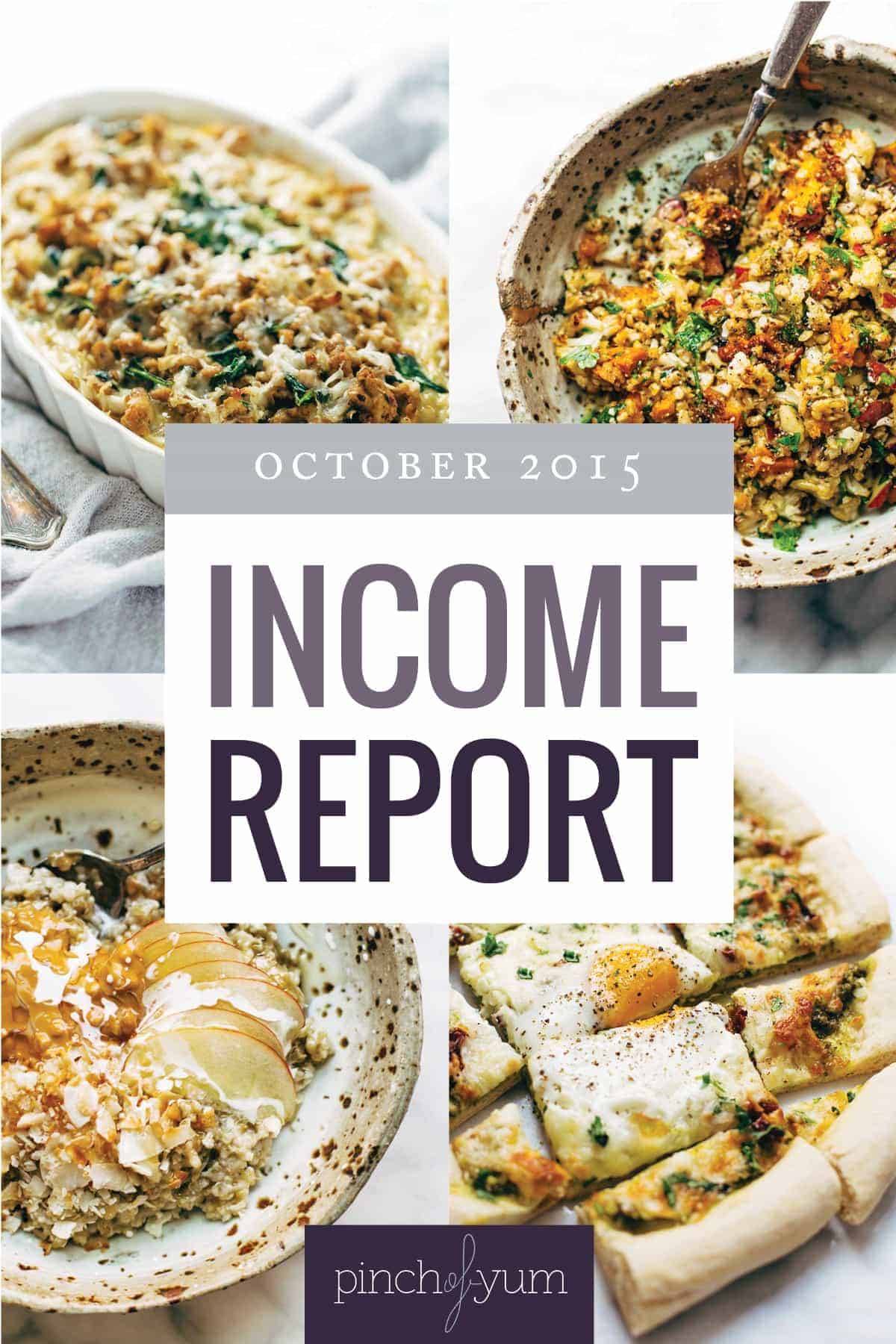
Hiya! Bjork here checking in for Pinch of Yum’s monthly traffic and income report.
Before we jump in I wanted to provide a quick reminder that we’re closing off enrollment to Food Blogger Pro this Thursday at 11:59 pm CST. That’s soon!
Click here to sign up for Food Blogger Pro before the doors close.
The next public enrollment won’t be until the Spring of 2016.
More on that in a bit, but first, the official intro…
What are these reports all about, anyway?
Let me explain…
The first time we wrote a post like this was way back on September 5th, 2011. We wanted to figure out if it was possible to create a business from a food blog.
Here’s a quote from that post:
Thanks for taking a peek at the inner workings of Pinch of Yum. We’re excited to learn more about creating an income from a food blog. Every month we’ll check back in and share what we’ve learned, and in the meantime, please let us know if there is any information (traffic, specific analytics, additional resources) we can share that would be helpful or interesting for you to know. For now, please accept our invitation to join us in this venture!
My favorite part of that lil’ blurb? The last sentence: “…please accept our invitation to join us in this venture!”
We’ve loved meeting, connecting with, and hearing stories from people that have followed along with these reports over the years, each “joining us” in their own unique way.
One thing that we’ve learned as we’ve continued in this journey is that the most important thing is the process, not the destination. It’s about falling in love with the work that you’re doing and figuring out ways to continue doing it each and every day.
True, there are times when it will be a struggle and you need to push through, but The Goal should never be reaching the goal, The Goal is to have goals that you truly love working towards.
If you love the work or love the feeling that you feel after you do the work, then you’ve arrived. You can still have goals, and you should, but you’ve reached The Goal if you love working towards your goal.
Does that make sense? The difference between The Goal and the goal?
Achieving The Goal (capital G) is internal. It’s controlled by you. It’s mindset based. You never check it off your list. It’s the process.
Achieving the goal (lowercase g) is external. It’s list based and can be checked off a list once you achieve it. It’s the destination.
We have a tendency to focus on goals and not as much on The Goal. People will do things, often for years at a time, that aren’t a good fit for them and don’t align with their passion, skills, or abilities. All in the name of reaching a goal.
So how do get closer to The Goal?
Reflect, refine, and repeat.
Reflect on your work. Where do you feel like you experience flow? What do you enjoy doing the most? What are the things you look forward to working on?
Refine your work. How can you make small shifts that allow you to do more of those things that you enjoy and where you experience flow. You should be looking for ways to increase the time you spend on things that align with your passion, skills, and abilities. It doesn’t have to be a drastic change. What’s one small habit or task you can refine?
Repeat #1 and #2.
As you do this you’ll continue to discover work that isn’t a good fit for you while being able to focus more and more on work that is a good fit for you. And the more you enjoy the work you do the more you’ll enjoy the work (obvious but important). This is The Goal, and achieving it will help you reach your goals.
It bears repeating that you’re not looking for easy work, you’re looking for work that “fits you.” Oftentimes the work we enjoy the most is a little bit challenging – it’s work that stretches us and makes a bit uncomfortable.
My hope for these reports is that they encourage you to continue moving towards The Goal, which in turn helps you achieve your goals.
Let’s take a look at the numbers for October.

A quick note: Some of the links below are affiliate links. All of the products listed below are products and services we’ve used before. If you have any questions about any of the income or expenses you can leave a comment and I’ll do my best to reply.
Income
- Workshops – $9,381
- AdThrive – $9,911.70
- Bluehost – $7,705.00 –> this income comes from a page where we show people how to start a food blog in three easy steps.
- Sponsored Posts/Speaking – $6,000.00
- sovrn – $3,637.26
- Tasty Food Photography – $3,558.30
- Yellow Hammer Media – $3,439.28
- Federated Media – $2,618.83*
- Gourmet Ads – $2,375.55
- Amazon Associates – $2,003.78
- Food Innovation Group – $1,732.82
- Swoop – $1,533.78
- How to Monetize Your Food Blog eBook – $535.00
- Genesis Theme – $455.67
- Elegant Themes – $89.00
- Martha’s Circle – $21.65
- AWeber – $14.40
*Federated Media is delayed with releasing earnings reports, which means we don’t have hard numbers when we publish these reports. We estimate earnings by using CPM earnings from last month and multiplying that by the traffic we experienced this month.
Expenses
- Theme Development – $6,000.00
- Rent (and Deposit) – $5,500.00
- Support Staff – $2,545.00
- Travel – $1,672.64
- eBook Affiliates – $738.70
- ActiveCampaign – $716.23
- Food Expenses – $707.80
- Media Temple (Hosting) – $350.00
- PayPal Transaction Percentage – $210.77
- Eventbrite – $189.05
- MailChimp – $186.00
- Amazon S3 and Cloudfront – $143.51
- Facebook Advertising – $127.41
- Overwhelmingly – $79.00
- Apps and Misc. – $72.62
- LeadPages – $67.00
- Adobe Creative Cloud – $53.55
- Zapier – $50.00
- Feedly – $45.00
- PayPal Website Payments Pro – $30.00
- Shoeboxed – $29.95
- E-Junkie – $28.00
- QuickBooks – $26.95
- SumoMe – $20.00
- VaultPress – $20.00
- Buffer – $10.00
- Backupify – $9.00
If you’re interested in learning more about some of the ways that you can monetize a food blog, we encourage you to download this free ebook, “16 Ways to Monetize Your Food Blog,” from our sister site, Food Blogger Pro!
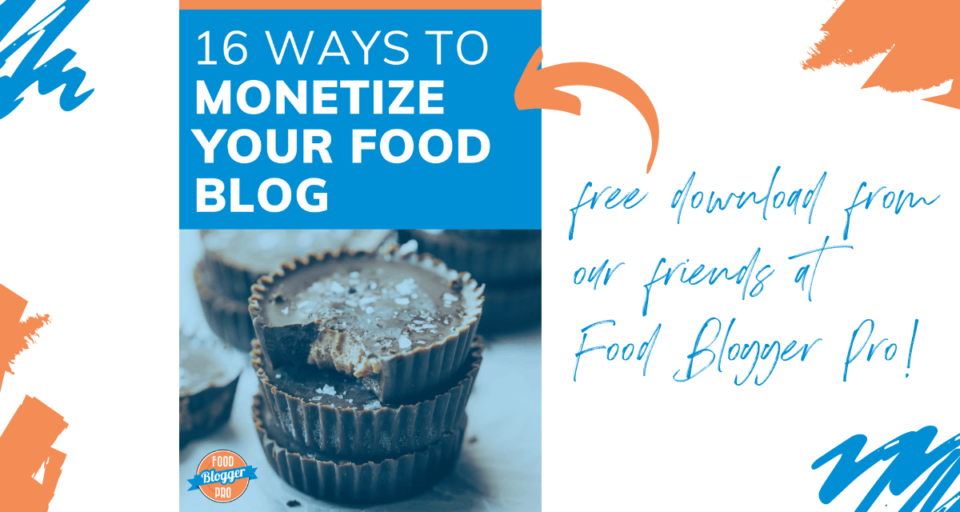
Traffic Totals
Below are some screenshots from Google Analytics.
Traffic Overview

Top Ten Traffic Sources
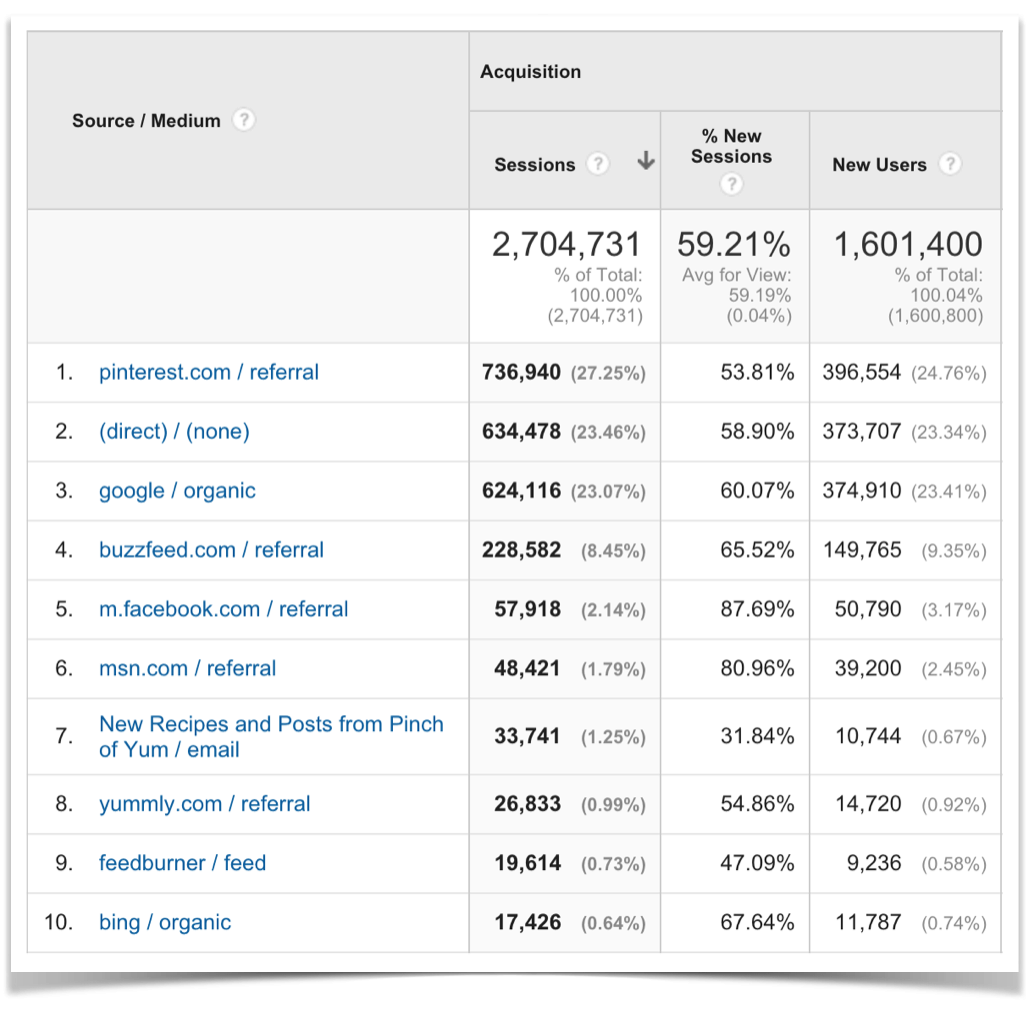
Mobile Vs. Desktop Vs. Tablet
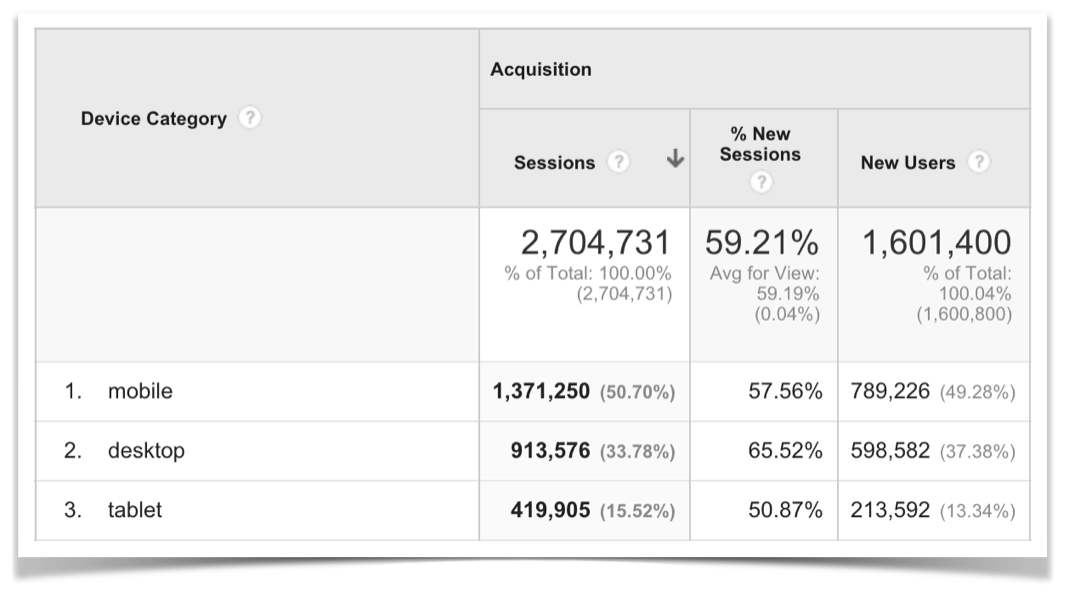
Top Traffic Channels
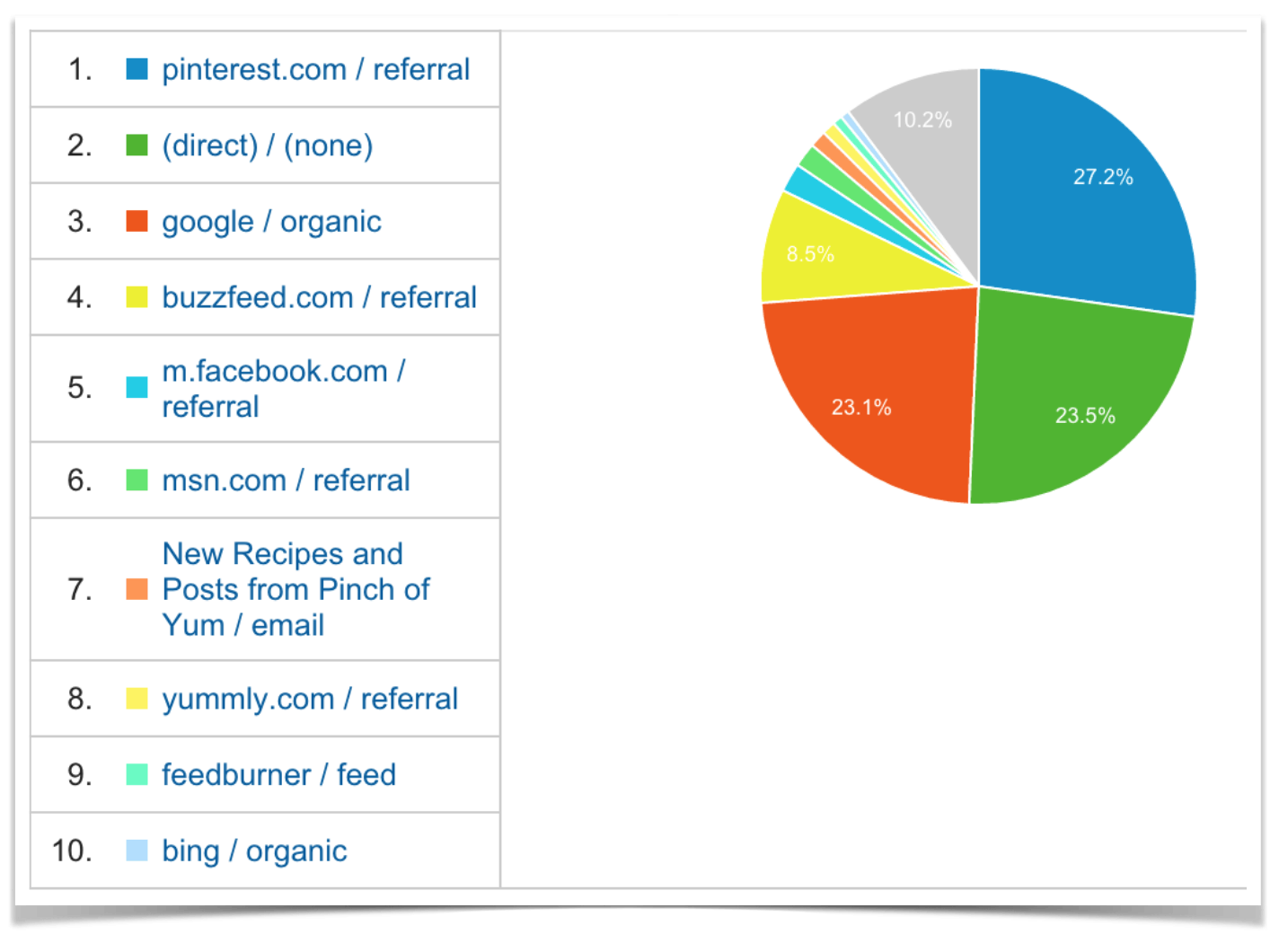

Why The Open and Close For Food Blogger Pro?
One of my favorite marketing concepts is Jab, Jab, Jab, Right Hook. It comes from wine-guru-turned-social-media-guru Gary Vaynerchuk.
Jab, Jab, Jab, Right Hook is a boxing analogy. The best way to win in boxing isn’t by coming out and throwing right hooks. It’s by doing lots of little jabs. The idea crosses over into marketing like this: Most people throw right hooks (asking) without doing any jabs (giving).
The switch to an open and close for Food Blogger Pro allows us to have two seasons – a giving season (jab) and an asking season (right hook). Right now we’re in the asking season (our “ask” is signing up for Food Blogger Pro). You’ve probably noticed this if you follow along closely with what we’re doing here on Pinch of Yum or on FBP. We’re emailing, mentioning it on social, and pushing for sign-ups in ways that we normally don’t (like at the beginning of this post).
At 11:59 pm CST on Thursday (when FBP closes) we’ll switch into a giving season. We’ll publish podcast episodes, do these monthly income reports, create free eBooks, and publish photography related posts on Pinch of Yum. Oh, and recipe posts. Lindsay will still do plenty of those. These are jabs – things that we’re giving.
We’re also viewing these two seasons as the marketing season and the member season. Right now, in the marketing season, we’re focused on signing up new members. After this we’ll switch into the member season, focusing in on the needs of the members of Food Blogger Pro.
Before the open and close structure, we were constantly juggling the two things: Trying to market while at the same time serving the members. Giving while at the same time always asking.
While you’ll still see us mention Food Blogger Pro you won’t see much about signing up, at least not until 5–6 months from now.
The Value Of Ads and The Value Of a Niche
We hosted an AMA video chat recently with a focus on blogging and Food Blogger Pro. We had some incredible questions come through. I wanted to talk about one of the questions today because I think it’s a really important concept to understand.
The question comes from Alexa:
Is it possible to turn a food blog into your full-time gig without using ads? I feel like they take away from the “user experience” because they can be so distracting and/or tacky.
The short answer: Yes. 100% possible.
The reason I want to bring this up is that we haven’t done a great job of demonstrating that on Pinch of Yum. We’ve done a decent job, but not a great job. At least not in these income reports.
One of the reasons is because we don’t include any earnings from Food Blogger Pro, so at a quick glance it can seem like the majority of our income comes from ads. True, a lot of it does, but it’s about 50/50 when you include Food Blogger Pro in the mix.
Here’s the difference between POY and FBP:
- Pinch of Yum: High Traffic + General Audience.
- Food Blogger Pro: Low Traffic + Specific Audience.
What’s the best strategy if you’re wanting to create an income from a blog using ads?
A high traffic blog with a general audience lends itself well to monetizing through ads. Most of the high traffic sites or media outlets we use are monetizing this way.
Facebook. Mashable. CNN. Instagram. The Serial Podcast. MSN. Pinterest. ESPN.
You could include Pinch of Yum in this group as well. It’s a high traffic blog with a general audience that creates the majority of its income from ads – both native ads (sponsored content) and traditional ads (CPM based banner ads).
The advertising transaction is based on attention economics.
A high-traffic website works hard to build something that people pay attention to and then they sell some of that attention, in the form of sponsored content or ads, to companies that want to give their brand some attention.
In general, the more traffic that comes in the higher the income potential is. With businesses like this, more traffic usually means the potential for more income, regardless of the interests or demographics of the people that are visiting.
One of the things I worry about with doing these income reports is the potential for people to think that this way – the high traffic + general audience + ad-based way we create an income from Pinch of Yum – is the best way. It works for us, but it doesn’t have to be how you build your thing. It’s entirely possible to build a blog – even a food blog – and not have an ad-based income.
What’s the best strategy if you’re wanting to create an income from a blog but not use ads?
Serve a specific niche.
Serving a niche will free you from having to play the high traffic + ad game and instead allow you to focus in on creating a solution (by creating your own product or being an affiliate for another company) for a really specific segment of the market. There are lots of people and brands that are doing this, many of which are smaller companies.
Whole 30. Jeff Goins. Simple Green Smoothies. Learn Scrivener Fast.
You can include Food Blogger Pro in that list as well. Our goal isn’t necessarily to increase general traffic to Food Blogger Pro because an increase in traffic won’t help unless that traffic is people from a specific niche – people interested in starting or growing a food-related website.
So if you’re interested in building a food-related blog or website and you know that you don’t want to use ads or sponsored content then I’d really encourage you to find a niche that you’re going to focus on.
Learn everything you can about the people in that niche and focus all your time and energy on helping them solve their problems or improve their lives using three things:
- Free content (blog posts, podcasts, downloads, social media)
- Opt-in content (email opt-in to get access to eBooks, webinars, video courses)
- Paid content (either yours or someone else’s)
Thanks for the great question Alexa!
Emails and Zaps
The closing of Food Blogger Pro has been the first real “campaign” that we’ve done with email. It’s been fun, but man…it’s a lot of work. The majority of front-end work came in the form of segmenting and tagging our email lists.
You might remember in August’s report I shared a bit about the importance of segmenting an email list, especially if you’re sending marketing-related emails. The idea is that you want to send the right message to the right people instead of just blasting your entire list with a generic message.
For instance, if I’m sending a Food Blogger Pro marketing email I don’t want to send that to people that are already members of Food Blogger Pro.
We use two primary tools to accomplish this:
- ActiveCampaign (for email and segmenting)
- Zapier (for automating the tagging of contacts)
A quick note: If you’re just getting started with your blog, then ActiveCampaign is probably more than you need. I’d suggest starting with something a little less feature-heavy (and more affordable) like MailChimp.
Call me a nerd, but I get pretty excited about how these two tools can work together.
Here’s an example of how this works:
- We send an email out to our email list about joining Food Blogger Pro.
- Someone decides to join FBP.
- They sign up using PayPal (or Stripe).
- We have a “Zap” (that’s what Zapier calls an automated process) that connects PayPal with ActiveCampaign. This allows ActiveCampaign to get “pinged” and update the contact as having signed up for an FBP membership.
- Next time we send out a marketing email about FBP the contact won’t get the email because they’re tagged as a member.
Here’s what that Zap looks like in Zapier:

And here’s an example of what tags look like in ActiveCampaign:
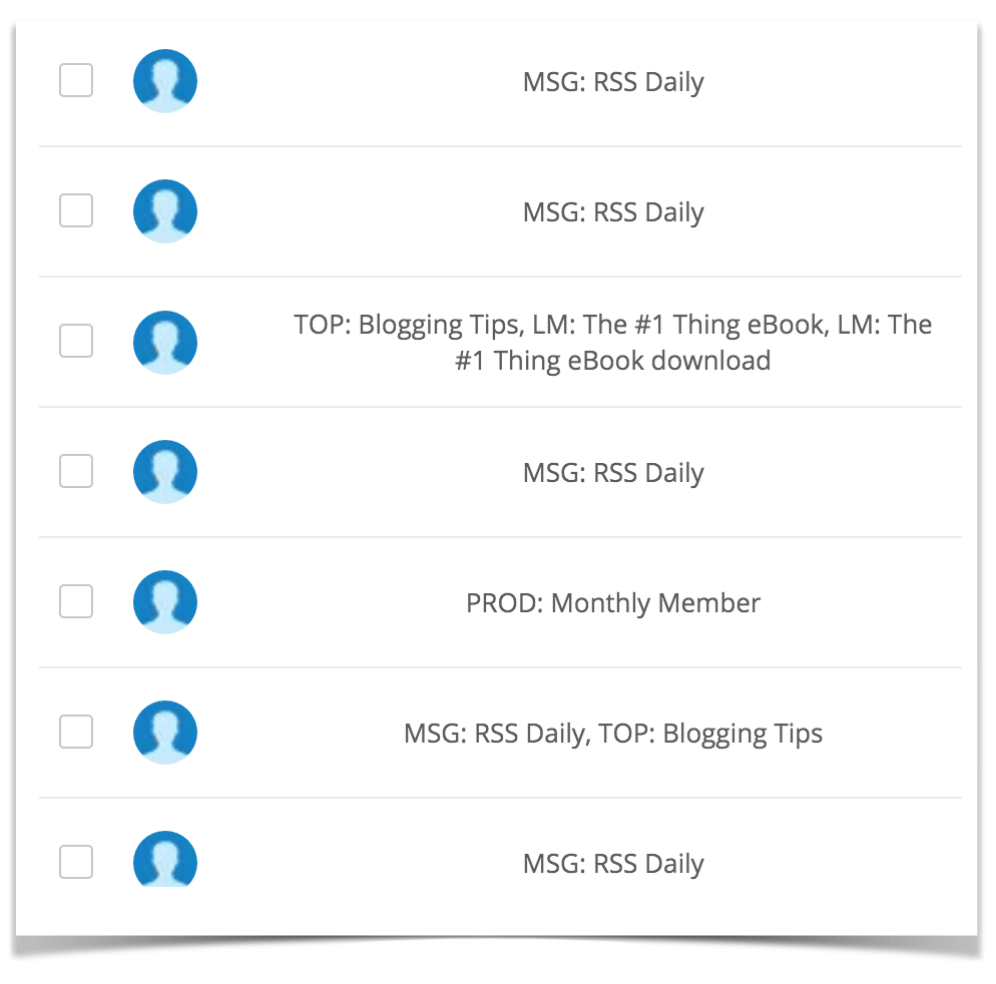
You can see how those two tools can work together to create some really cool combinations, which in turn help you craft more intentional and deliberate messages to your subscribers.
Both ActiveCampaign and Zapier are pretty intense, so if you decide to use them be sure to dedicate some time for learning.
Countdown Timer
This is a quick fun one to end on because I know I’ll get a lot of questions about it.
The countdown timer!
I’m referring to the one we’re using in the beginning of this post (and below as well).
Here’s why we’re doing that:
Our readers and subscribers come from all around the world, so saying that the doors close at 11:59 pm CST is only somewhat helpful. It requires a lot of math and/or Googling. The countdown timer is nice to have because it shows exactly how many hours and minutes are left. It’s a much more visual representation than just the words 11:59 pm CST.
I went deep into research mode trying to find a way to put a countdown timer into emails and blog posts. I had seen some other people do it but couldn’t figure out what they were using. Then I came across MotionMail. It was exactly what I needed!
It’s super easy to use. You pick the date you’re counting down to, the time zone, and the design elements (fonts and colors) and then it creates a countdown timer in the form of a GIF.
Here’s an example of the settings for the timer that you see below:
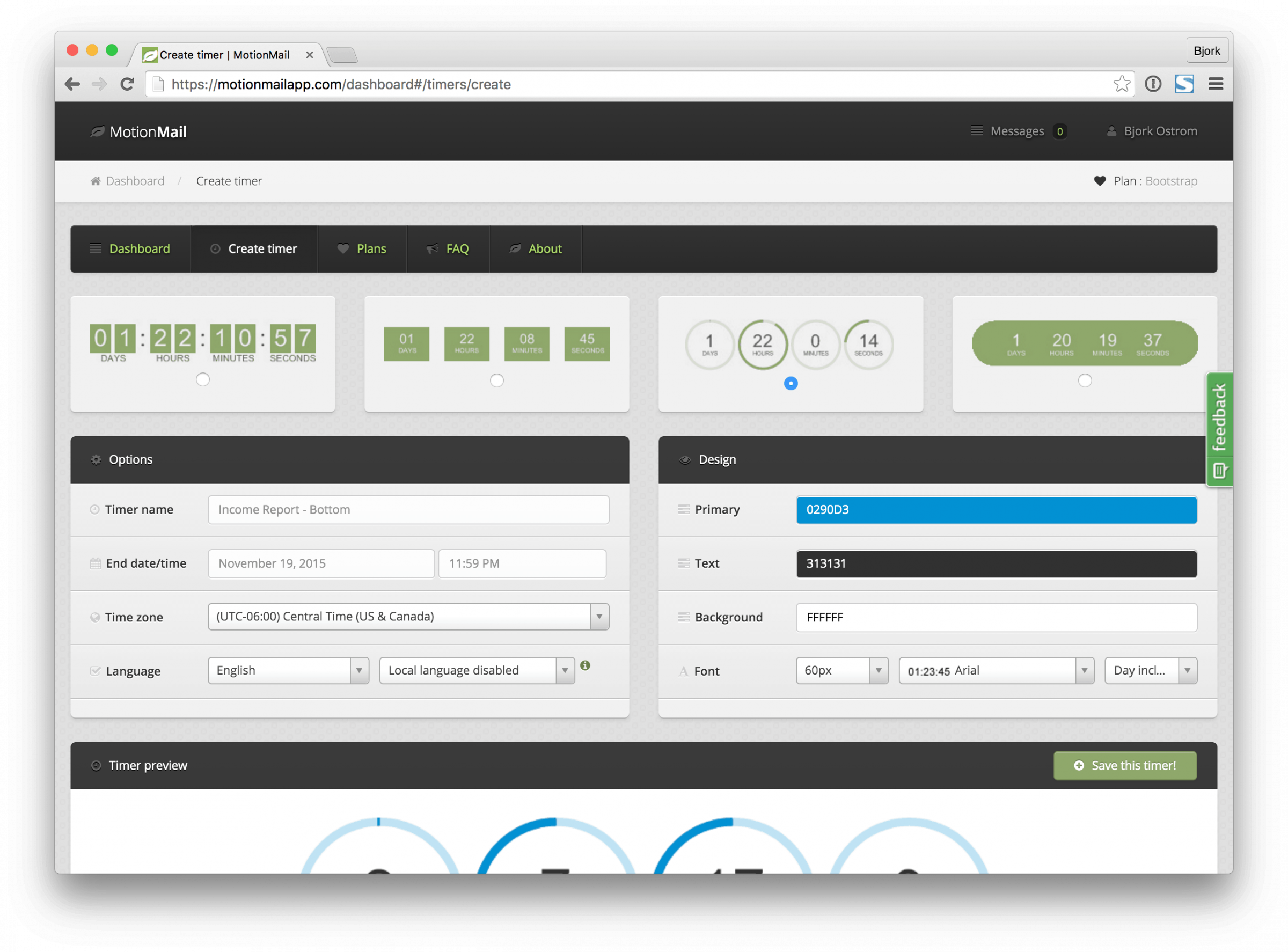
Any ideas what this countdown timer is for?
The time left to sign up for Food Blogger Pro of course! 🙂
Because Of You
Lindsay and I fully realize that it’s because you – the readers, commenters, silent observers, and share-with-your-friend-ers – that Pinch of Yum is what it is today.
Thank you. We really appreciate you.
This month we’re donating a portion of Pinch of Yum’s income to the Boxes of Love project here in the Twin Cities.
Lindsay’s cousin Aaron and his wife Erica work for Cru Inner City which is the organization that helps organize this project. We really value the work that they’re doing to make the Twin Cities a more love-filled place.

Each Thanksgiving they partner with local churches to deliver Boxes of Love, which includes a complete holiday meal for hungry families, enough for a family of six.
